Bike Commuting Saved Me $4k in 2021
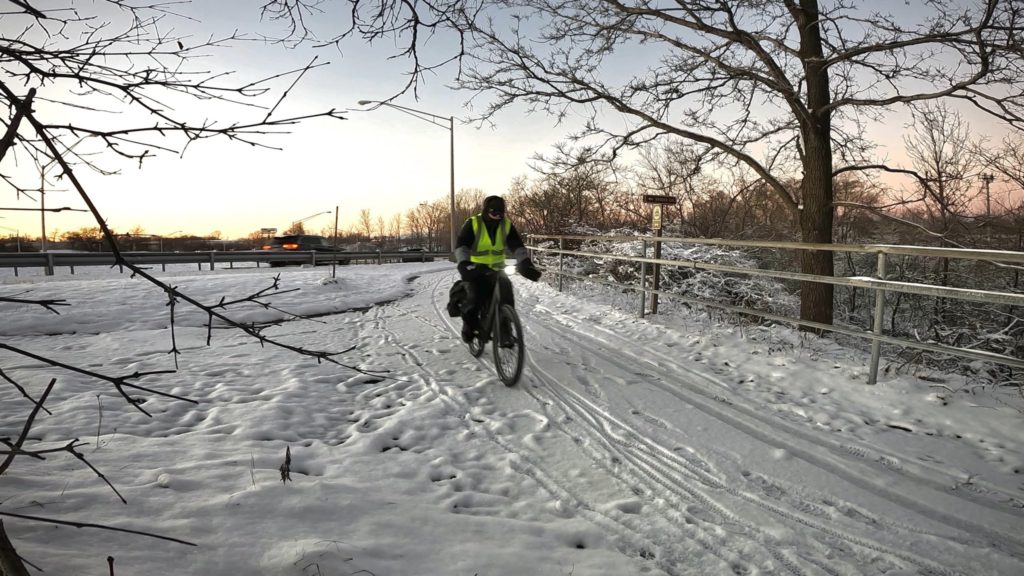
Fade-in to December 2020. I was moving back to the US after living in the EU for a year and had decided to forego the purchase of a car…for one year. I would be bike commuting, walking, and bumming rides for one year.
This article is a recounting of that process. How I figured it out and how I saved $4,785.79 in 2021 by not owning a personal vehicle.
My Circumstances
I’m blessed to have a life and a job that allows me to make this decision by choice, not out of necessity.
That is why I call this an experiment. It may not last beyond the year.
Living without a car is a fairly common thing in several major cities in the United States. New York City, Chicago, Boston. Cities that have mass transit infrastructure and high population density.
I don’t live in a major city.
I live and work in Rochester, New York. We have no intercity train, subway, or express bus service. (We do have a bus service, but the average trip takes 3x longer than a car ride.)
I have a full-time, middle-class job on the west side of the city. My job affords me the ability to work remotely on occasion.
I’m single and have no children.
The Costs of Owning a Car
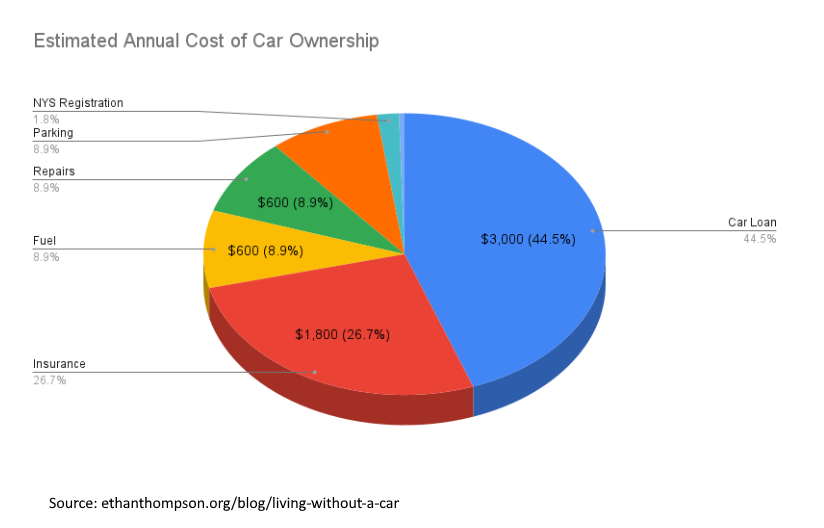
One of the major considerations for the experiment was the cost savings. An article from MrMoneyMustache on “The True Cost of Commuting” is what inspired me to think critically about this.
I estimated that the yearly cost of owning a car would be around $6,749.
That breaks down into the following categories:
- Car loan – $3,000 a year
- Insurance – $1,800 a year
- Fuel – $600 a year
- Repairs – $600 a year
- Parking – $600 a year
- NYS Registration – $119 a year
- NYS Inspection – $30 a year
The (Estimated) Costs of Not Owning a Car
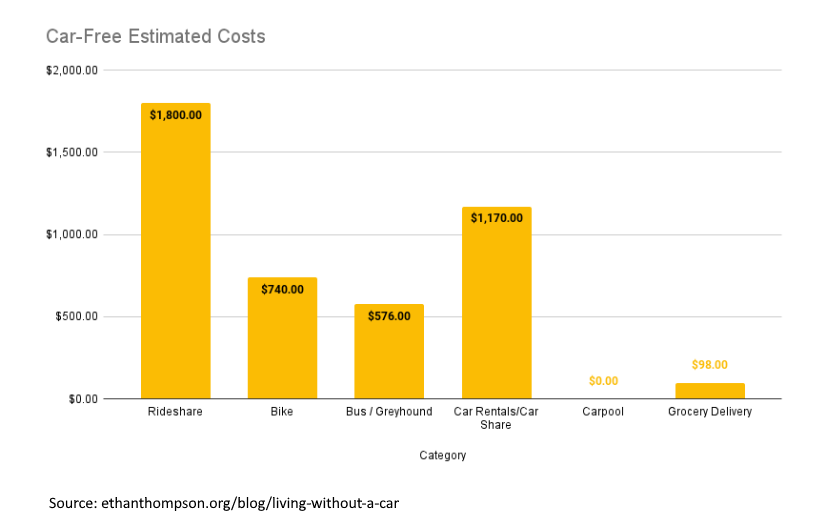
I estimated that the yearly costs of transport without a car would be $4384.
That breaks down into the following categories:
- Electric bike – $740 (assuming the bike lasts me 2 years and monthly electricity costs were $15)
- Rideshares (Uber/Lyft) – $1,800
- Renting a car for trips – $1,170
- Bus pass/Greyhound trips – $576
- Grocery Delivery – $98
Assuming that my estimates are correct, that would be an annual savings of $2,455 or roughly 36% over the costs of owning a car.
But in reality, I saved much more than that.
The Actual Costs of Living Without a Car

I actually spent $1,963.21 on transportation in 2021.
Which means I actually saved $4,785.79 or roughly 71%.
All the Data
I’ve compiled all of my data into a nice spreadsheet for myself because I love spreadsheets. Here are the highlights:
Count of all trips
- I used my bike for 203 trips in 2021.
- I carpooled for 66 trips in 2021.
- I used a rideshare service (Uber, Lyft) for 19 trips in 2021.
- I used a car share/car rental service for 4 trips in 2021.
Number of miles
- I traveled 1482 miles by bike in 2021
- I traveled 504 miles by carpool in 2021
- I traveled 78 miles by rideshare (Uber, Lyft) in 2021
- I traveled 98 miles by car share/car rental in 2021
Cost of transportation modes
- Biking cost me $1,491.08 in 2021 (This is the full cost of my bike, repairs, accessories, etc.)
- Carpooling cost me $69 in 2021 (gas, coffee, meal for friend)
- Rideshare services cost me $255.13 in 2021
- Car share/car rental services cost me $50 in 2021
Why I saved so much more than I estimated
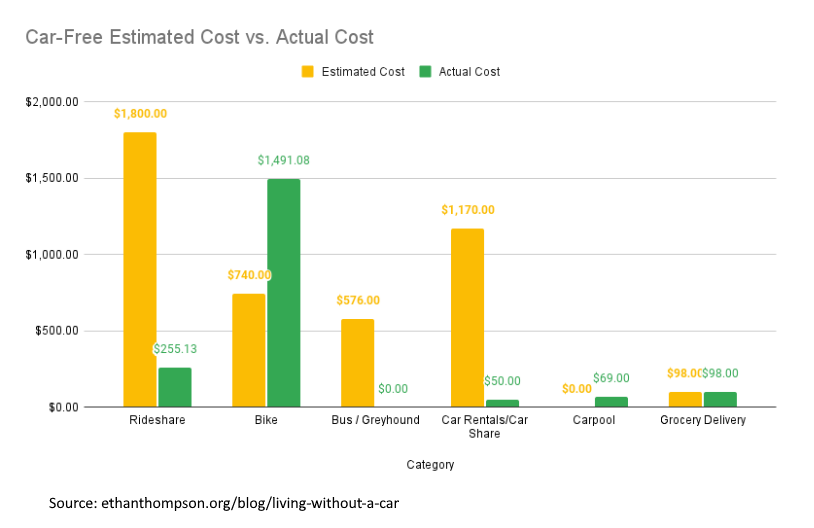
I rented a car for just a few days compared to the 30 days that I budgeted for within the year.
My parents also visited me or I hitched a ride with my sister so I didn’t need to take Greyhound to see them.
I only took 2 rideshares a month on average. Which was 8 less trips per month than I estimated.
I never rode the bus.
A few weeks after moving into my apartment I found out a coworker of mine lived in the same building. So on wet or snowy days where I couldn’t ride my bike I just bummed a ride.
If I had taken the bus it would have cost me $120 for the entire year, so the cost savings there were marginal. But it was much more convenient and comfortable, I’m very thankful for having kind coworkers. Thanks, Caleb!
The Lifestyle of the Frugal and Car-free
Not owning a car in a mid-size city in the United States does require some specific lifestyle choices. I wouldn’t say that it makes it “hard”, but it does require planning.
Luckily, I enjoy planning. As you probably could have guessed by now. So here is how I planned, managed, and lived my life without owning a car.
Location, Location, Location (Where I lived)
I chose to live downtown. This comes at a “premium” in terms of cost of living. The average 1-bedroom in downtown Rochester, NY costs about $1100 a month. If you live farther out you can get a 1-bedroom for around $700-900.
This is a price I would pay regardless of my transportation. I just like living downtown and being close to restaurants, breweries, and events. But it is relevant because if I had chosen to live in one of the suburbs it would have been much harder as bus routes are farther away or non-existent and rideshares would have cost more.
For example, my barber is just over a mile away from my apartment. So I just walk there when I need a trim. If I lived in the suburbs getting to a barber would probably be a 2 or 3 mile trip. Which is fine when you have a car, but walking or riding your bike in the rain for 2-3 miles for a haircut isn’t very fun.
My E-bike for Bike Commuting
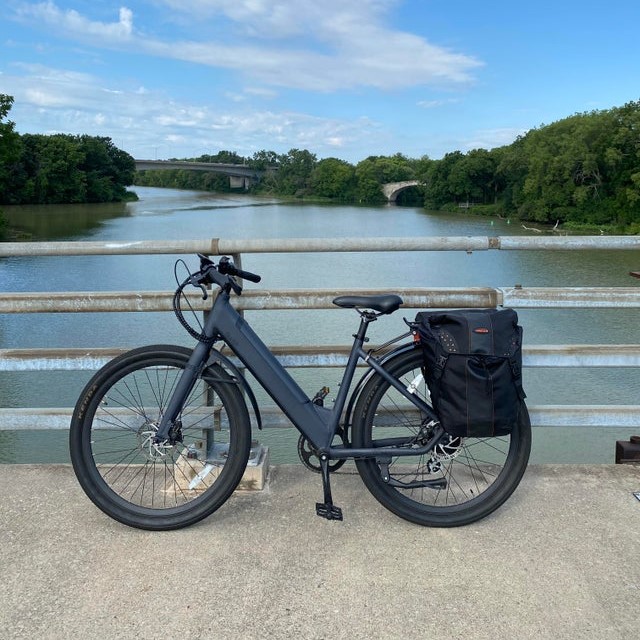
In December 2020 I purchased a Core 5 from Ride1Up. It is a class 3 (by NYS standards) e-bike but I operated it in class 2 when using public roads and trails. The bike looks great, rides smoothly, and has been a large part of my car-less journey. I would highly recommend checking out the Core 5 if you’re looking for a low-cost e-bike for commuting.
Relying on Friends
It would be easy to ignore the fact that at least once a month I relied on a friend to help me out. Whether that was picking up couch, grabbing some lumber from Home Depot, etc.
But, I don’t see that as a real downside. So much of my life is viciously independent that it’s easy to isolate myself. So I think it is healthy to have to swallow my pride and simply ask for help on occasion.
I’m also blessed to have friends who are willing to help me out and aren’t annoyed by it. But a lot of that comes down to communication. If they’re annoyed or can’t help, that’s okay. No hard feelings, I’m the one asking for favor.
How I got Around
The following is a breakdown and some data on how I actually got around and accomplished everyday tasks. These are in essence answers to the questions that were posed to me by friends and family when I decided to embark on this experiment.
Bike Commuting Was a Blast
To get to work I took three methods of transportation: carpooling, bike commuting, and rideshares.
I rode my bike to work 172 times in 2021.
I loved riding my bike to work. Taking the trail system in the city takes me about 20-25 minutes each way. But the activity brings me a lot of joy and provides a great mental break. Even if I owned a car I would have still opted to bike commute as often as I could, it’s just that fun.
I carpooled 53 times to get to work in 2021.
Like I mentioned before, I happened to live in the same building as a car-owning co-working.
If I didn’t have this luxury, I would have had to take the bus. That wouldn’t have been a large monetary cost, but it would have increased the amount of time I spent commuting. My commute would have been almost an hour every day instead of 20-40 minutes.
I used a rideshare service (Uber, Lyft) 17 times to get to work 2021.
When my coworker couldn’t give me a ride, weather was too rough for bike commuting, and I needed to get to work for a time-sensitive meeting I took an Uber or Lyft. If I had planned ahead of time I could have taken the bus for most of these trips. But, that is a cost I was willing to absorb because of its convenience.
Getting Groceries without a Car
I had groceries delivered 21 times.
I used Walmart’s grocery delivery service for this task. Their Walmart+ plan costs $98 a year and includes free delivery.
I actually used this service back when I had a car because I don’t enjoy grocery shopping.
I get the same staple items over and over again. I also find that going to the grocery store causes me to make more last-minute purchases. These end up costing me more and are normally unhealthy items.
On occasion I also rode to the store on my bike. Similarly to bike commuting, this everyday task is just more fun on a bike. But after a full workday, I’d rather someone just bring my groceries to me.
Bumming a Ride to Hang with Friends
I used a ridesharing service 2 times to get me to an event.
Most of the things I enjoy center around sitting at home on my computer. But, occasionally, I do go out with friends. Because of my close proximity to the restaurants, bars, and breweries in the city that’s just a short walk or rideshare away.
Reflections after a Year of Bike Commuting
Do I regret making this decision? Not in the slightest. Between the money I saved, the experiences that I had, and the exercise it was a win-win-win for me.
I also have a much better idea of what my life would be like if I couldn’t afford a car. Say I lost my job or had to hit reset on my life. Having that knowledge and confidence is very valuable to me.
But there are some interesting things to think about.
4 years ago, this wouldn’t have been possible
One of the interesting things about this whole experiment is that it would have been much more difficult to do this 4 years ago.
- We didn’t have Uber in Rochester until 2018.
- We didn’t have Walmart grocery delivery until 2018.
These two services made my year without a car fairly frictionless and cost-effective compared to owning a car.
Riding a Bike in Rochester Still Kinda Sucks
While the city has done things to make riding a bicycle in Rochester much more enjoyable and safe over the past few years, it still kinda sucks.
Don’t get me wrong, it is getting better and I truly appreciate the effort that has been made by the City of Rochester.
We only have 2 separated bike lanes in the entire city and one of them is in college town, which isn’t a dense area like downtown. The other is less than a mile long and doesn’t do a whole lot in terms of connecting areas with residential housing and city services or entertainment areas.
The Genesee river trail and canal path are the best examples of bicycle infrastructure the city currently has and are well maintained in the summer months and lots of fun to ride.
However, bike commuting in the winter is a bit of a different story. None of these trails are entirely plowed or salted in the winter. Winter lasts around 5 months in Rochester.
So while getting around the city from North to South is a 5 out of 10 because of the existing trails, getting from East to West and through downtown are a 3 out of 10 to me.
If we want the city to truly be bike friendly, the East-West route needs a separated bike lane or cycletrack and we need winter maintenance.